Climate discussion is arguably ‘saturated’, say photographer Claudius Schulze and cultural programmer Sithara Pathirana, Artistic Director and Programme Director of the Klima Biennale Wien (1). The aim of this biennale is not to exhaust visitors with information but to recognise the ‘scale and momentum’ of the crisis with creative and innovative artwork (work spans visual art, sound, performance and more). Klima doesn’t ask visitors to visit every site, artwork or event – it invites them to ground themselves in the city and participate in the elements that speak to them, and this active role prevails throughout the festival.
The team is interested in how community and agency impact our understanding of, and engagement with, climate and ecological breakdown. This recalls ’s (2) manifesto, which encourages ‘interventions for individuals, communities and organisations that empower individuals to contribute to more sustainable practices and vice versa’, and seeks ‘bring agency to people who want to be involved by giving them a voice’. How can we lower barriers to entry by stretching our modes of communication?
The biennale houses a wealth of projects, initiatives and artworks that display thoughtful and worthwhile collaborations between people who might be described as ‘artists’ and ‘scientists’, and doesn’t go light on things we might describe as ‘information’ or ‘research’. Refreshingly, the festival has no motto and it’s not branded to oversimplify complex ideas. In total, we visited Klima Biennale Wien for three days, and this is what stood out, nudged us or sparked questions.

Day 1:
Into the Woods, curated by Sophie Hasslinger, is hosted at KunstHausWien (open 365 days a year), the Biennale Central and a spectacular wobbly, stitched together building, developed by visual artist and architect Friedensreich Hundertwasser, an early environmentalist and hater of straight lines (as something ‘which does not exist in nature’ and leads to ‘absolute tyranny’).
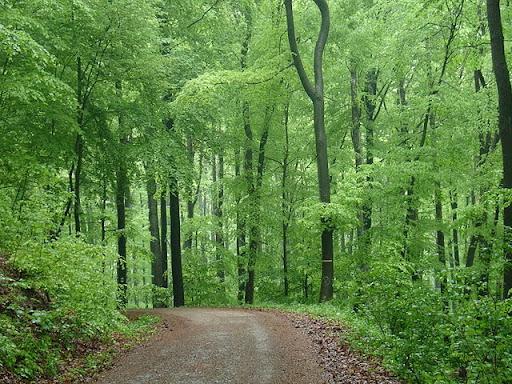
Into the Woods considers our and other species' relationships to the forest ecosystems, one of which surrounds Vienna (der Wienerwald). It focuses on the breakdown of these woodland spaces via deforestation, monocultures and climate change, and how their human treatment changes or connects globally.
Throughout the exhibition are ‘fact boxes’ by scientists from local universities or institutions, providing a way into a complex broader subject. The team noted that it was difficult to simplify complex ideas like soil health within monocultures into a few paragraphs for a layperson and at times these felt separate, as though knowledge was being siloed into artistic and scientific perspectives.
We felt at home seeing two artists that featured in our recent special edition, Visible Signs That Something Isn’t Right; Abel Rodríguez (or Mojave Guihu) and Richard Mosse, especially given that these stood out as transdisciplinary collaborations.
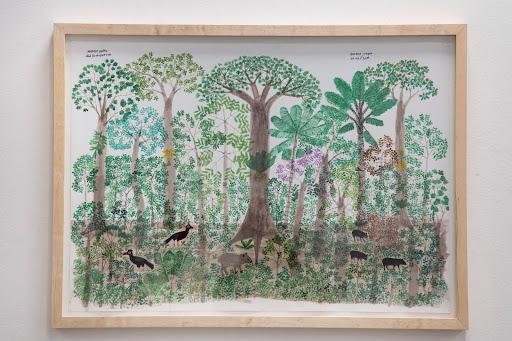
Abel Rodríguez is a sage of the Nonuya people, coming from a territory known as The Savanna, which sits between the Cahuirnarí River and upper Agar Paraná River in Colombia. Rodríguez possesses great ancestral knowledge about the ecology of the region, the plants and species that they live alongside. Conflict led to Rodríguez’s movement from the region, and a reliance on memory as knowledge. I question why there is no ‘fact box’ from Rodríguez – their knowledge is vast and deep.
Jeewi Li’s work Paths, and others like Richard Mosse’s Tristes Tropiques, probed ongoing questions we have about ‘aesthetics’ in climate-related visual art. Discussed as ‘aesthetic’, related to beauty or taste, what does it mean to produce ‘beautiful’ images of something so destructive? In Li’s case, the destruction is that of the bark beetle, while in Mosse’s, it is the violent ruin of Indigenous land. The use of ‘aesthetic’ patterns was also apparent in Diana Scherer’s Interwoven, where oat grass roots grow around templates that resemble tree rings or mycelium networks. Sometimes ‘scientists know too much, they say it’s not possible’ but Scherer proves it is.

Day 2:
Songs for the Changing Seasons
We start day 2 with an exhibition curated by Lucia Pietroiusti and Filipa Ramos. Pietroiusti is Head of Ecologies at Serpentine in London, and Ramos is a writer, lecturer and curator. Their collaboration sees ecology, multi-species perspectives and multi-sensorial work rooted into the Biennale festival site, Nordwestbahnhofstraße, an ex-bus depot. The artists in the exhibition are described as ‘story-keepers’, sharing insights and impressions with ‘gentleness and kindness’. The space felt intimate despite its scale, with audio and visuals grounding us in the present and questions, critiques and offerings that weren’t ‘solutionist’.
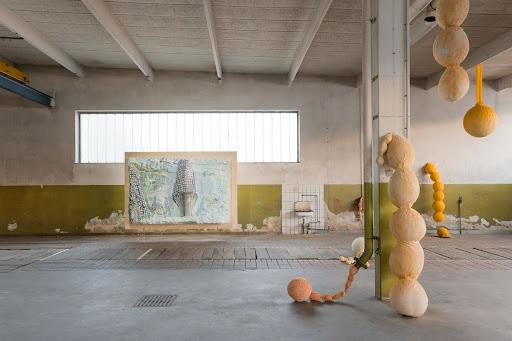
Sofia Jernberg’s Songs for the Changing Season welcomes us to the space with vocals that resemble human, animal and elemental tones, woven with Patricia Dominguez’s Balada de las Sirenas Secas, an immersive video installation and ‘mournful song to the drought’, created in collaboration with activists. Dominguez’s work uses humour and mythology to respond to the humanitarian crisis lit by the water privatisation in Chile, otherwise the subject is ‘just too heavy’. We spoke about visibility, how artwork can enable us to capture or communicate the utter dread and grief when the climate crisis knocks on your door.
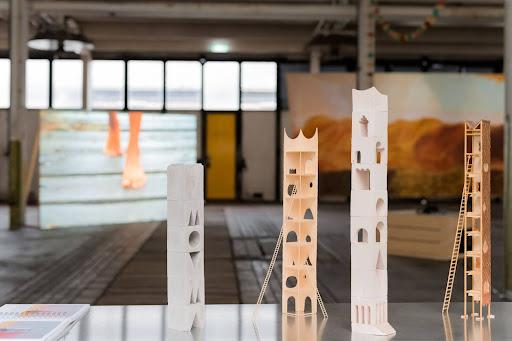
Fiction, or stretched realities, can be found throughout the biennale, prompting questions around how the value of imagination as it impacts real-world decision-making. Studio Ossidiana’s The City of Birds consists of a collection of small-scale models based on existing architectural models, and proposed new spaces that interrogate our relationship with birds. They reminded us of Invisible Cities by Italo Calvino – a book that encourages the reader to question 55 fictitious cities. The City of Birds presents mediative propositions to probe your own ideas around multi-species ecologies and living.
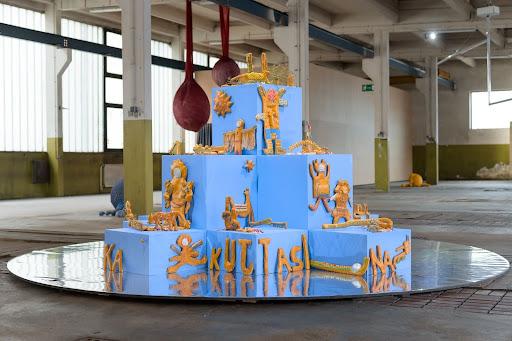
As part of Songs for the Changing Seasons, Natalia Montoya explores the Andean funerary bread-making technique of the T’anta wawa (3) and local Viennese baking methods to produce an edible work. Ajayu borrows ecological motifs from Viennese architecture, merging flower designs with Andean symbols like potatoes to develop a picture of two ecologies. Montoya plans to then burn the bread and bury the ashes in Vienna, ‘to complete the circle of the flour’. When asked what would happen if rodents eat the work before it can be burnt, Montoya replied ‘who am I to stop them?’.

Day 2 was full of great work – other notable mentions go to Yussef Agbo-Ola and Olaniyi Studio's 12 Claws in Cloud Dust, whose endangered insects encase the site, Laure Winants (Foto Arsenal Wien) From a Tongue we are Losing, a transdisciplinary exploration of the colour and quality of Arctic ice, and MAK’s anthropogenic explorations, via posters, protests, and their investigative design lab – a must do if you're visiting Klima.
Day 3:
We zoom in for day 3, seeing smaller independent spaces that are part of Immediate Matters – a network of activities, performances, labs and protests that make space for local knowledge, activist groups and radical grassroots, and aim to action systemic change.
Many of these projects exhibit the collaborations between artists and scientists that pepper Klima. For example, Johanna Tinzl’s In the Wake of the Tipping Point at Mz*Baltazar’s Lab, a family-run feminist hackspace with a focus on the intersection between the arts, technology and gender. Working with glaciologists, Tinzl has produced models of glaciers in Austria and Iceland, and presented them in succession based on their altitude, calling them ‘him’ and ‘her’ – entities. Or solo art and science collaborations like Mid-air collisions by Kathrin Stumreich at discotec. Stumreich uses vibrations caused by lasers to make sounds that replicate birds attracted to an insect-frequented solar plant in the Mojave Desert, where 150,000 mirrors concentrate strong sunlight. The use of performance and technology within the space bridges disciplines and ways of working, honouring research and practicality, and storytelling and imagination.
Final thoughts:
Klima Biennale Wien is more than artworks and spaces focused on climate, it is a web of artists, activist events and speculations. It’s multi-generational; hundreds of children are making manifestos to share with Austrian policy makers, and it’s future-facing with community walks throughout the city bringing together old and new members of the movement.
The team recognises that they are not perfect. Cars will be used, coffee drunk and paper printed, but interesting steps were taken with productions – few artworks were loaned from outside Europe to reduce the large emissions of global shipping, merch was printed on second hand garments and signs painted onto walls. This limiting of options and relinquishing of control is not a step taken by many curators and organisers, and in this case it bred innovation.
Gerlinde Riedl (General Director of the Biennale), Claudius Schulze (Artistic Director) and Sithara Pathirana (Programme Director) now want to open a space to discuss ‘waste being part of the cycle of making work.’ We’re excited to see how the Biennale develops and changes, asks more critical questions, and invites more unusual ears and eyes. Could this be the start of a new ritual that challenges normal art production, exhibition and critique?
Footnotes/notes:
- The Biennale will take place every 2 years. This year it’s running from 05/04/24 until 14/07/24 at 2 main sites, Biennale Central (at KunstHausWien) and the Biennale festival site, slightly outside the city centre. However, museums, galleries and indie spaces peppered throughout Vienna are involved in the Biennale by hosting climate-focused work during the period.
- Ecological Citizens are a research project based at the Royal College of Art in collaboration with the University of York's Stockholm Environment Institute and Wrexham Glyndŵr University, with the mission to foster positive climate action.
- T’anta wawa, or baby bread, are sweet bread rolls shaped and decorated as children or infants, to celebrate their life or death.
More Reads
Welcome to part two of an IFLA! two-part mini series on climate curation and exhibition (you can find the first here). In this second piece, It’s Freezing in LA! Art Editor and Co-Director Nina Carter meets with the Eden Project’s curation team. They discuss their recent exhibition, Acts of Gathering, which explores our changing relationship to food in the context of the climate crisis – and in the process continue our discussion of themes such as the grey area between art and science, community building, and the act of spanning time.
Keep reading >
Art
Climate and Exhibition: Acts of Gathering at The Eden Project
By Nina Carter(Interview)Art
Climate and Exhibition: Acts of Gathering at The Eden Project
Keep readingWelcome to part two of an IFLA! two-part mini series on climate curation and exhibition (you can find the first here). In this second piece, It’s Freezing in LA! Art Editor and Co-Director Nina Carter meets with the Eden Project’s curation team. They discuss their recent exhibition, Acts of Gathering, which explores our changing relationship to food in the context of the climate crisis – and in the process continue our discussion of themes such as the grey area between art and science, community building, and the act of spanning time.
By Nina CarterKeep readingWelcome to part one of an IFLA! two-part mini series on climate curation and exhibition. In this first piece, It’s Freezing in LA! Art Editor and Co-Director Nina Carter meets with Ashish Ghadiali and Ben Borthwick to discuss Against Apartheid, a Plymouth based exhibition, organised by Radical Ecology, run by Ghadiali to discuss themes including the grey area between art and science, community building, and the act of spanning time.
Keep reading >
Art
Climate and Exhibition: Against Apartheid at KARST
By Nina Carter(Interview)Art
Climate and Exhibition: Against Apartheid at KARST
Keep readingWelcome to part one of an IFLA! two-part mini series on climate curation and exhibition. In this first piece, It’s Freezing in LA! Art Editor and Co-Director Nina Carter meets with Ashish Ghadiali and Ben Borthwick to discuss Against Apartheid, a Plymouth based exhibition, organised by Radical Ecology, run by Ghadiali to discuss themes including the grey area between art and science, community building, and the act of spanning time.
By Nina CarterKeep readingArt
Review: Venice Architecture Biennale 2025
Keep readingBobby Jewell visits the 2025 Venice Architecture Biennale on behalf of It's Freezing in LA!. He finds dangerous technotopian greenwash from the central curator's pavillion, but silver linings amid the various international international contributions. The Biennale will be open until the 23rd November 2025. Edited by Katie Urquhart.
By Bobby JewellKeep reading- Read more